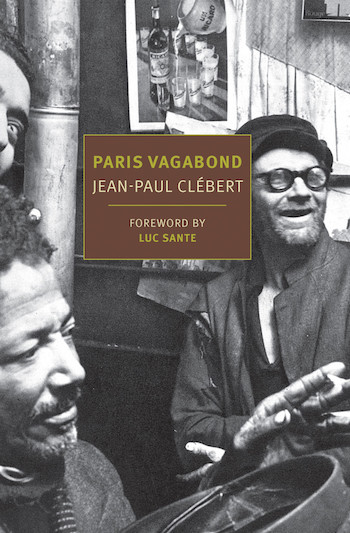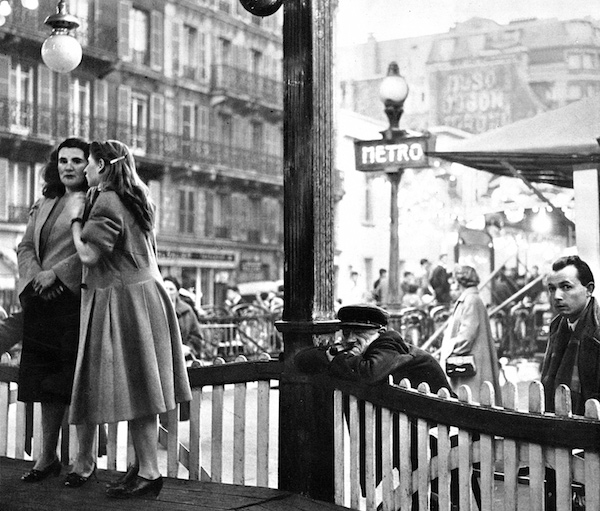Fuse Book Review: Poetry in the Rough — Jean-Paul Clébert’s Graphic Evocations of a Clandestine Paris
An extraordinary book that should be in the hands of every lover of the French capital. And don’t we all love Paris?
Paris Vagabond, by Jean-Paul Clébert, translated by Donald Nicholson-Smith. Photographs by Patrice Molinard. New York Review Books Classics Original, 334 pp., $18.95.
By John Taylor

“Leisurely strolls quite obviously (and fortunately) unknown to the tourist trade,” writes Jean-Paul Clébert (1926-2011) in his fascinatingly graphic Paris Vagabond, “for there is nothing to see on these routes except for poetry in the rough.”
Poetry in the rough, indeed. Clébert’s acute insider’s view of the erstwhile clandestine “Zone” of Paris and other rundown quarters in 1944-1948, and the striking photographs by Patrice Molinard (1922-2002) that accompany the text, make an extraordinary book that should be in the hands of every lover of the French capital. And don’t we all love Paris?
Clébert’s descriptions are memorable—sometimes funny, sometimes touching, sometimes sobering—and ever precise. They stem from his meticulous, open-minded, and especially open-hearted exploration of streets onto which few contemporaneous Parisians ever ventured. Inquisitive and resilient to hardship, he focuses on “the oddities, the peculiar, the offbeat and startling, caught in motion, captured unawares.” Above all, Clébert shows how ragpickers, hoboes, bums, winos, and sundry down-and-outs like himself—for he shares their lot—manage to get by, eating (a little), drinking (a lot), and sleeping (more or less). “I know some priceless places to flop behind some garages,” he explains, for instance:
I climb. I go over a couple of walls, and now I am chez moi, in a courtyard at the far end of which are sheds that are never locked, ragmen’s storage places where I can settle in, snug as a bug in a rug, among piles of paper and sacks. I chew on my last bite of the day, spit it out, and so to bed. The trick is to wake before daybreak, before the arrival of the fleamarketers, who take a dim view of intruders.
“The city is inexhaustible,” he declares with the sort of pluckiness that must have kept him going during his rugged “personal investigation” and that is palpable on every page. “And to master [Paris] one must […] be either a vagabond poet or a poet vagabond.” A wandering prose poet he surely is, for Paris insolite — as it is titled in French — is composed in a distinctive style that shows a surrealistic delight in strangeness, heterogeneity, and happenstance, and in what he calls, quoting the writer Pierre Mac Orlan, “le fantastique social.”
Interestingly enough, as Luc Sante reminds us in his excellent Foreword, the name “Clébert” is actually the penname of a scion of “a bourgeois family (whose identity remains unknown) in the wealthy suburb of Neuilly-sur-Seine.” He was educated in a Jesuit boarding school in the equally chic quarter of Passy, from which he ran away at age of seventeen and joined the French Resistance.
In the immediate postwar period, Clébert—whose uncommon pseudonym, speculates Sante, might be based on “clebs,” a slang term for “dog”—spent time with outcasts scraping a living just outside the city limits in the “Zone,” with the Maximoff Romany clan at Porte de Montreuil, with impoverished Jews who had escaped deportation to the Nazi death camps and who were living on or near Rue des Rosiers in the Marais, and with the clochards hanging out on Place Maubert and Rue Mouffetard.
The latter street in the Fifth Arrondissement is on all the tourist itineraries nowadays. Known for its open-air market and Greek restaurants, the prices are high and the rents in the area are out-of-sight. Yet however neatly repainted and renovated, the old buildings still vaguely evoke the quartier populaire that existed just after the war, and bums still loiter near Saint Médard’s Church at the bottom of the street. Writing in situ on “multicolored and multifarious scraps of paper” such as “used envelopes, newsprint edges, [and] unfolded Gauloise packets, Clébert accurately recorded all the human depth behind what we see today. He unforgettably describes places and objects, relishes in absurd dada-like juxtapositions of things and events, but his book is especially full of the flesh and bones of humanity. This is why Paris Vagabond is timeless, and timely.
He was genuinely attentive to odd bedfellows and fellow tramps, noting their talents that enabled them to survive. One acquaintance made his underclothes out of newsprint:
I met one anonymous clochard, however, clearly of no fixed abode but nonetheless with a perfect knowledge of the possibilities of paper, who had designed a whole undergarment, covering even his arms and legs, out of newsprint held together with glue and string, reinforced at his joints and at his body’s sharper points. Carefully tightened around his extremities by means of ingenious sewing, this strange costume, whose weak spots he must unfortunately repatch from time to time, though without replacing the whole thing, adheres to his skin and fuses with his body hair and allows him to stroll about town in the middle of winter seemingly clad only in thin canvas pants and a seaman’s jersey, thus arousing admiration for his remarkable indifference to the elements, except of course for rain, which he flees like the plague, and for good reason.
The vagabond poet knew such subject matter inside out. He acquired his first experience of Paris at street level as a hawker of newspapers. “For several months I sold L’Intransigeant during that paper’s glory days,” he recalls, “striding at a rapid pace down the Grands Boulevards with my papers under my arm, mechanically uttering the hallowed cry: “L’Intran, get the latest, L’Intran!”

One of the dozens of photographs of Paris taken by Patrice Molinard for the 1954 edition of “Paris Vagabond.” Photo: courtesy of the New York Review of Books Classics.
When only a few copies were left, he would sit, he tells us, “at the café that is now an imposing but always empty brasserie on Place du Havre, where I would set my bundle of papers down on a table and watch it dwindle all by itself as I drank a rum, watching out of the corner of my eye as the coins tumbled down in a regular cascade and waiting for the waitress from the café-tabac nearby, who was sharing my room for reasons of economy.”
Most passages, however, deal with harsher realities. There are no more rooms shared with waitresses. Homeless, Clébert would roam through entire quarters, in fact slowly journey back and forth across the City of Lights—while passing beneath the dim streetlamps of sleazy side streets much more often than through the brightness of the boulevards. It would take him some three weeks to migrate from “the hospitable quays of Grenelle to the Zone at Les Lilas,” all the while keeping in his threadbare haversack “a couple of shirts, a toothbrush (that small, ridiculous-looking object whose possession meant I was still not a true bum), a packet of tea, a box of matches and a bar of soap.”
Alongside such self-ironic comments, Clébert can observe pointedly: “You always come back to the same old question: how are you going to eat?” […] How are you going to eat once you find yourself at the other end of Paris and the cold makes you acutely aware of your need of a hot meal before you can steel yourself for a night under the bridges?”
The writer reveals how he and other vagrants struggled to solve this daily problem, and many others. This book is thus a handbook, a memoire, indeed a “personal investigation,” as well as a travelogue of “itineraries,” which Clébert defines as “sentimental” ones. And a French classic long overdue in English, which has been given a vivid rendering by Donald Nicholson-Smith.
John Taylor has lived in France since 1977. He is the author of the three-volume collection of essays, Paths to Contemporary French Literature (Transaction Publishers), and has translated books by many French and Francophone poets, including Philippe Jaccottet, Pierre-Albert Jourdan, Jacques Dupin, Georges Perros, and José-Flore Tappy. His book Some Sort of Joy (Cedar Hill, 2000), which has been translated into French as Une certaine joie (Tarabuste, 2009), evokes the hidden life of the ordinary streets of a medium-sized French provincial town.
Tagged: Donald Nicholson-Smith, Jean-Paul Clébert, NYRB Classics Original, Paris Vagabond
